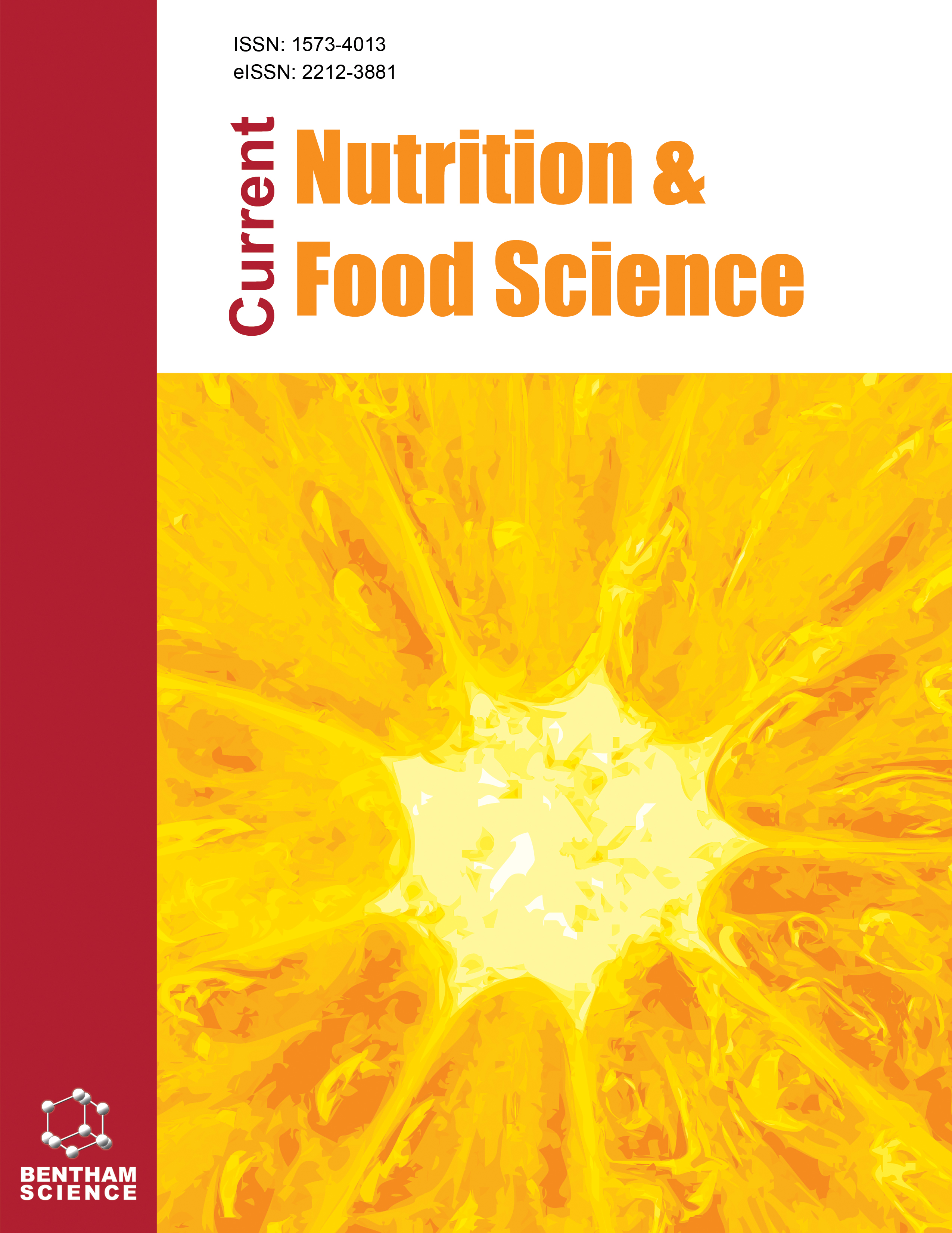- Home
- A-Z Publications
- Current Nutrition & Food Science
- Previous Issues
- Volume 18, Issue 8, 2022
Current Nutrition & Food Science - Volume 18, Issue 8, 2022
Volume 18, Issue 8, 2022
-
-
The Organic Life According to Traditional Chinese Medicine with Anticancer Approaches
More LessAuthors: Mohamad H. Shahrajabian, Qi Cheng and Wenli SunThe aim of this review was to summarize the most important traditional medinical herbs and plants that are being used in different parts of the world with a focus on a green anticancer approach. The most important impacts of medicinal plants on cancer treatments are prevention of cancer occurrence, decreased side effects, ameliorated post-operative complications, reduced post operative recurrence, reduced tumor grow Read More
-
-
-
The Importance of Nutrition and a Balanced Diet in the Elderly during the COVID-19 Pandemic
More LessAuthors: Özge Esgin and Tayyibe ErtenBackground: Age is an important risk factor for the mortality rate in the COVID-19 disease, and mostly, hospitalised patients over 60 years with chronic diseases are at high risk of death due to this disease. Along with preventive measures, proper nutrient intake might be helpful in maintaining a healthy state or reduce the severity of the COVID-19 disease in the elderly. Methods: The search was carried out in the Pu Read More
-
-
-
Potential Benefits of Pila ampullacea, Tempeh, Moringa oleifera Leaves as Nutritional Support for Hemodialysis
More LessBackground: Hemodialysis patients can experience problems, including proteinenergy malnutrition, infection, disorders of the immune system, and inflammation. One etiology of malnutrition in hemodialysis is inadequate energy and protein intake, making patients need nutritional support, which can be fulfilled by local Indonesian foodstuffs. Objective: This paper aimed to review the potential health benefits of snails (Pila ampullac Read More
-
-
-
Antifungal Role of Common Indian Spices & Herbs: A Narrative Review
More LessAuthors: Pratyusha Vavilala, Aayushi Deo, Divya Prakash, Muskan Tiwari and Vibhuti AggarwalA large variety of spices can be found in kitchens worldwide. The usage varies from region to region as per the cuisine. They hold nutritional values and are being exploited for their anticancer, antifungal, antibacterial, antiulcer, anti-inflammatory properties. This study highlights some of the commonly used Indian spices for their antifungal properties and summarizes their potential antifungal activity. Fungal diseases are deep Read More
-
-
-
A Comprehensive Review on Ethnopharmacology and Phytochemistry of an Underutilized Plant Cordia dichotoma L.
More LessAuthors: Mohammad Abdullah, Shazia Usmani and Poonam KushwahaCordia dichotoma L. (Family Boraginaceae), a well-known medicinal plant, has been traditionally used for thousands of years for the treatment of various diseases. Several studies have been undertaken to assess the pharmacological potential of different parts of the plant, namely roots, stem, flower, and leaves, for their antioxidant, antimicrobial, hepatoprotective, antidiabetic, anticancer, antifertility, antifungal, and wound hea Read More
-
-
-
Micronutrient Fortification in Foods and Soy Milk, a Plant-based Milk Substitute as a Candidate Vehicle
More LessAuthors: Baishakhi De and Tridib K. GoswamiBackground: Food fortification is an effective intervention strategy to combat micronutrient malnutrition, hidden hunger, and for improvement of public health and nutritional status. Choice of a cost-effective, widely consumed, compatible, and stable candidate vehicle is essential for successful fortification. Objective: This comprehensive review discusses the aspects of food fortification along with the suitability of soy milk, a plan Read More
-
-
-
Phytopharmacological Review of a Food Supplement Zingiber officinale Roscoe (Zingiberaceae)
More LessZingiber officinale, a medicinal herb commonly used in Ayurveda belongs to family Zingiberaceae and is reported to have various therapeutic properties. Roots as well as rhizomes of this plant are commonly used in the treatment of digestive disorder. It has also been used as expectorant, spasmolytic, anti-tussive, anti-allergic, antihistaminic activity and inhibits coughing. The roots and rhizomes are rich sources of essential Read More
-
-
-
Reinventing Plantain as a Functional Food: A Processing Based Approach
More LessAuthors: Mehak Arora, Prasad Rasane, Jyoti Singh, Sawinder Kaur, Manish Bakshi and Jaspreet KaurPlantains are termed as ‘culinary bananas’ due to the fact that they are only consumed after cooking or other forms of processing. Providing good nutritional value and versatility in diet, it is considered an important commercial crop and an efficient dietary staple in Africa. However, irrespective of geographical locations and economic status of diverse ethnic groups, plantains are consumed extensively due to their easy availabilit Read More
-
-
-
Therapeutic Effects of Modified Tempeh on Glycemic Control and Gut Microbiota Diversity in Diabetic Rats
More LessAuthors: Rio J. Kusuma, Jaka Widada, Emy Huriyati and Madarina JuliaBackground: The role of the gut microbiota in improving glycemic control in diabetic patients is gaining attention. Tempeh is a fermented soy food from Indonesia that has antidiabetic and antidysbiotic effects. Interestingly, modification of tempeh processing by adding lactic acid bacteria has been reported to enhance the antidiabetic effect of tempeh. Aims: This study aimed to evaluate the effects of modified tempeh on seru Read More
-
Volumes & issues
-
Volume 21 (2025)
-
Volume 20 (2024)
-
Volume 19 (2023)
-
Volume 18 (2022)
-
Volume 17 (2021)
-
Volume 16 (2020)
-
Volume 15 (2019)
-
Volume 14 (2018)
-
Volume 13 (2017)
-
Volume 12 (2016)
-
Volume 11 (2015)
-
Volume 10 (2014)
-
Volume 9 (2013)
-
Volume 8 (2012)
-
Volume 7 (2011)
-
Volume 6 (2010)
-
Volume 5 (2009)
-
Volume 4 (2008)
-
Volume 3 (2007)
-
Volume 2 (2006)
-
Volume 1 (2005)
Most Read This Month
Article
content/journals/cnf
Journal
10
5
false
en


